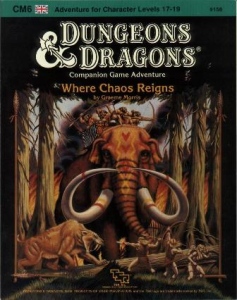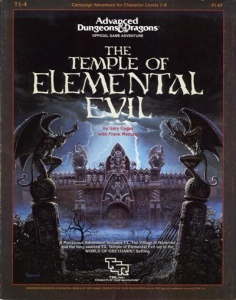
The Temple of Elemental Evil is an adventure module for the fantasy role-playing game Dungeons & Dragons, set in the game's World of Greyhawk campaign setting. The module was published by TSR, Inc. in 1985 for the first edition Advanced Dungeons & Dragons rules. It was written by Gary Gygax and Frank Mentzer, and is an expansion of an earlier Gygax module, The Village of Hommlet. The Temple of Elemental Evil is also the title of a related 2001 Thomas M. Reid novel and an Atari computer game.
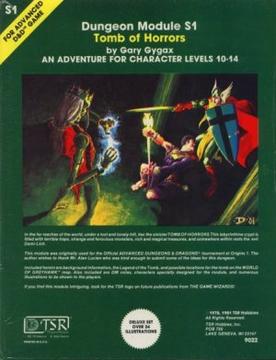
Tomb of Horrors is an adventure module written by Gary Gygax for the Dungeons & Dragons (D&D) role-playing game. It was originally written for and used at the 1975 Origins 1 convention. Gygax designed the adventure both to challenge the skill of expert players in his own campaign and to test players who boasted of having mighty player characters able to best any challenge. The module, coded S1, was the first in the S-series, or special series of modules. Several versions of the adventure have been published, the first in 1978, and the most recent, for the fifth edition of D&D, in 2017 as one of the included adventures in Tales from the Yawning Portal. The module also served as the basis for a novel published in 2002.

Ravenloft is an adventure module for the Dungeons & Dragons (D&D) fantasy role-playing game. The American game publishing company TSR, Inc. released it as a standalone adventure booklet in 1983 for use with the first edition Advanced Dungeons & Dragons game. It was written by Tracy and Laura Hickman, and includes art by Clyde Caldwell with maps by David Sutherland III. The plot of Ravenloft focuses on the villain Strahd von Zarovich, a vampire who pines for his lost love. Various story elements, including Strahd's motivation and the locations of magical weapons, are randomly determined by drawing cards. The player characters attempt to defeat Strahd and, if successful, the adventure ends.
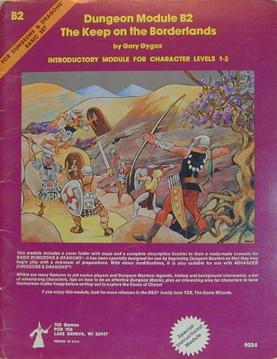
The Keep on the Borderlands is a Dungeons & Dragons adventure module by Gary Gygax, first printed in December 1979. In it, player characters are based at a keep and investigate a nearby series of caves that are filled with a variety of monsters. It was designed to be used with the Dungeons & Dragons Basic Set, and was included in the 1979–1982 editions of the Basic Set. It was designed for people new to Dungeons & Dragons.

In the Dungeons & Dragons role-playing game, an adventure or module is a guide for managing player knowledge and activities within a specific scenario. Commercially, a published adventure comes as a pre-packaged book or box set that is used exclusively by the Dungeon Master. It typically contains background information for the plot or story, maps, vignettes of interesting locations, site inventories, creature descriptions and statistics, player visual aids, and suggested rules for evaluating events and likely player actions.
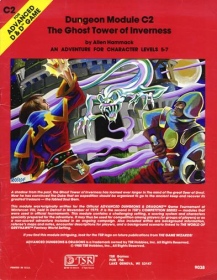
The Ghost Tower of Inverness is an adventure module for the Dungeons & Dragons fantasy roleplaying game, set in the game's World of Greyhawk campaign setting. The module's title refers to an ancient magical tower located in the southern Abbor-Alz Hills. The "C" in the module code represents the first letter in the word "competition," the name of C1 – C6 module series.

Return to the Keep on the Borderlands is a 1999 adventure module for the Dungeons & Dragons fantasy role-playing game. It is a sequel to the original The Keep on the Borderlands module (B2) from 1979. Both modules were published by TSR, Inc.
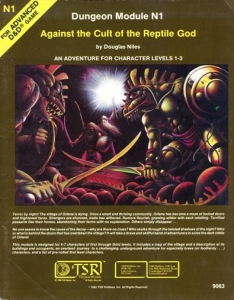
Against the Cult of the Reptile God is an adventure module for the first edition of the Advanced Dungeons & Dragons fantasy roleplaying game, set in the game's World of Greyhawk campaign setting. It is designed for novice players and gamemasters. The suggested party size is 4-7 characters of level 1-3.
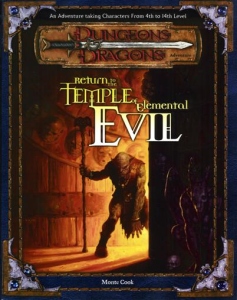
Return to the Temple of Elemental Evil is an adventure module written by Monte Cook for the 3rd edition of the Dungeons & Dragons fantasy roleplaying game, set in the game's World of Greyhawk campaign setting. It was originally published by American game company Wizards of the Coast in 2001 as a sequel to the 1985 Advanced Dungeons & Dragons (AD&D) module, The Temple of Elemental Evil.
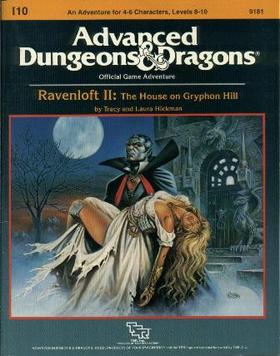
Ravenloft II: The House on Gryphon Hill is a Dungeons & Dragons module written for use with the First Edition Advanced Dungeons & Dragons ruleset, by TSR.
The DL series is a series of adventures and some supplementary material for the Advanced Dungeons & Dragons role playing game. These modules along with the Dragonlance Chronicles trilogy of novels, which follow one possible adventure series through the modules, were the first published items that established the Dragonlance fictional universe. The original DL series was released from 1984 to 1986, with the final two modules added to it in 1988. In the 1990s these roleplaying adventures from the original series were collected and revised for 2nd Edition AD&D as the three DLC Dragonlance Classics modules. There were also versions of the module series released in 1999, 2000 and 2006.

Dragons of Despair is the first in a series of 16 Dragonlance adventures published by TSR, Inc. (TSR) between 1984 and 1988. It is the start of the first major story arc in the Dragonlance series of Dungeons & Dragons (D&D) role-playing game modules, a series of ready-to-play adventures for use by Dungeon Masters in the game. This series provides a game version of the original Dragonlance storyline later told in the Dragonlance Chronicles trilogy of novels. This module corresponds to the events told in the first half of the novel Dragons of Autumn Twilight by Margaret Weis and Tracy Hickman. Its module code is DL1, which is used to designate it as the first part of the Dragonlance adventure series.
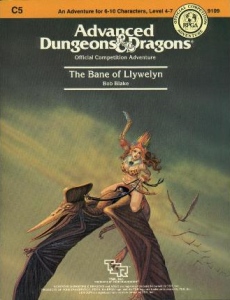
The Bane of Llywelyn is an adventure module for the first edition of the Advanced Dungeons & Dragons fantasy roleplaying game. The adventure was written by Bob Blake and published by TSR in 1985 as part of the Competition, or C-series of modules, and contains material first used in a tournament adventure at GenCon XVI. C5 The Bane of Llywelyn continues the story that started in C4 To Find a King.

Night's Dark Terror is an adventure module for the Dungeons & Dragons (D&D) fantasy role-playing game written by British game designers Jim Bambra, Graeme Morris, and Phil Gallagher. It was designed specifically for campaigns transitioning from the D&D Basic Set to the D&D Expert Set. The player characters (PCs) journey from a farmstead into uncharted wilderness, where they encounter new hazards and contend with a secret society. The adventure received a positive review from White Dwarf magazine.
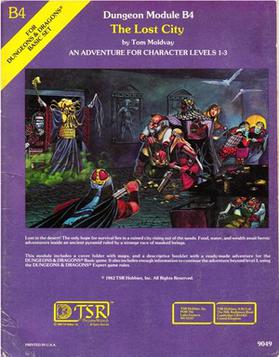
The Lost City (B4) is a Dungeons & Dragons adventure module by Tom Moldvay. It was first published by TSR in 1982 and was designed as a stand-alone adventure for use with the Dungeons & Dragons Basic Set. The working title for the module was "The Lost City of Cynidicea". Moldvay designed the module as a low-level scenario to give novice Dungeon Masters experience in fleshing out adventures such that it is only partially complete. The plot involves the player characters discovering a ruined subterranean city slowly rising out of the sands. The adventure is set inside a huge step pyramid, with the lower pyramid only sketched out and the city itself described with a list of the major areas and a map. The adventure's main villain is Zargon, a giant one-eyed monster and his minions. The entire double pyramid, not including the city, contains over 100 rooms.

Dwellers of the Forbidden City is an adventure module, or pre-packaged adventure booklet, ready for use by Dungeon Masters in the Dungeons & Dragons (D&D) fantasy role-playing game. The adventure was first used as a module for tournament play at the 1980 Origins Game Fair, and was later published by TSR in 1981 for use with the first edition Advanced Dungeons & Dragons rules. The module was written by game designer David "Zeb" Cook, who partly ascribes his hiring by TSR to his work on this module. In the adventure, the characters are hired to recover a stolen object from a hidden oriental-style city ruled by a snake-worshipping cult of yuan-ti and their mongrelmen and tasloi servants.
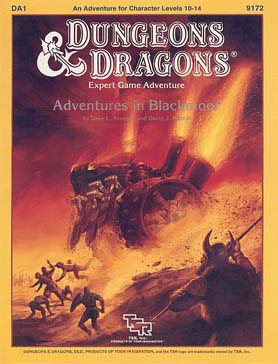
Adventures in Blackmoor is a 64-page Dungeons & Dragons fantasy role-playing game adventure, designed to be compatible with the Dungeons & Dragons Expert Set.

The Gates of Firestorm Peak is an adventure module for the second edition of the Advanced Dungeons & Dragons fantasy role-playing game. The adventure was published in 1996, and was written by Bruce Cordell, with cover art by Jeff Easley and interior art by Arnie Swekel.

Strixhaven: A Curriculum of Chaos is a sourcebook, published in December 2021, that details the Strixhaven campaign setting for the 5th edition of the Dungeons & Dragons fantasy role-playing game. The plane of Arcavios and its magical university Strixhaven were originally created for the Magic: The Gathering collectible card game and first appeared in the card set Strixhaven: School of Mages, which was released in April of the same year. The book is centered on the most powerful magic university in the multiverse and focuses on the lives of the player characters who attend its various colleges.

The Wild Beyond the Witchlight is an adventure module set in the Feywild for the 5th edition of the Dungeons & Dragons fantasy role-playing game.
